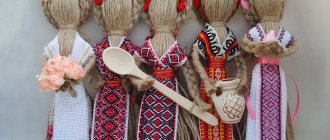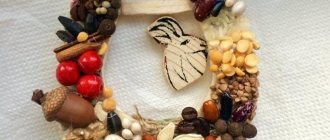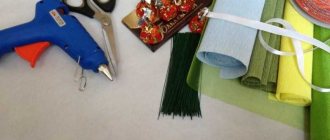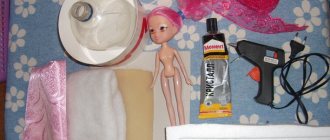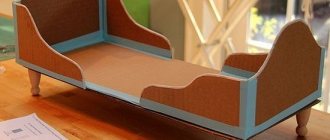History of dolls
Amulet doll-motanka.
According to historians, motankas appeared among the ancient Slavs, when they mastered the production of fabrics from flax. Each doll had its own purpose.
One symbolized good spirits, the second protected the family, the third protected travelers, the fourth helped women in childbirth.
Craftswomen advise making such amulets from burlap, jute, cotton or chintz. A beautiful toy will complement the interior and give it a special charm.
The origins of the talisman of the ancient Slavs
The Slavic motanka doll has transferred all its strength and protective purpose through time to the present day.
The hand-made motanka doll is considered one of the most ancient symbols of Slavic culture.
Since ancient times, a rag doll has been an integral attribute not only of every family in Rus', but also of every individual person. Even for babies, the mother lovingly shook the amulet, which endowed the baby with strength, health and protected from the evil eye.
Motanka doll - herbalist
When a man went to war, his family made a doll that was seated at the head of the table while he defended his homeland. Thus, it was believed that the warrior’s life was not in danger.
The Motanka doll contains many sacred cosmogonic meanings that were formed back in the Trypillian era
The tradition of creating such amulets has survived to this day. This is not just a tribute to the ancestors, but also an unshakable belief in higher protective forces. Rag dolls began to be made more than five thousand years ago. The first amulet made of threads and fabric was created by the pagan Slavs.
The art of making dolls goes back to ancient times.
In ancient times, it was customary to sacrifice women to the gods, but one day a living beauty was replaced with a rag dummy. The gods accepted the tribute and presented a generous harvest. Since then, they began to create all kinds of Slavic dolls, any of which was a talisman for the family, preserved the marriage, endowed them with health and wealth, and even fulfilled their most cherished dreams and desires.
Features of the amulet
A talisman or amulet created with your own hands is endowed with powerful protective powers. Since ancient times, our ancestors believed that it could protect from everything evil.
Motanka doll is a strong amulet
The main rule of creation is that you need to wind the threads with your own hands and strictly in one direction, according to the movement of the sun. This symbolizes Life itself and positively charges the amulet.
The motanka doll received its name due to a specific manufacturing technique.
Each rag doll had its own appearance, but the following points were required:
- the amulet should not have any knots, except one (in the navel area), as a symbol of the birth of a new life;
- the doll has no eyes to avoid the penetration of foreign energy;
- a cross is wrapped around the face as a powerful protection against any evil and evil spirits.
Creating a motanka doll is an act of rebirth.
There may be several face options, but all of them should be shaped like a cross, the ancient symbol of Lada - the goddess of all Slavic gods. In addition, our ancestors considered such a symbol to be a sign of fire, cutting off everything hostile, evil and alien to the human soul. The longer the thread, the more positive energy is deposited.
Reeling Rules
The creation of a rag talisman is symbolic: every movement is endowed with a special meaning, as it should be when a talisman is created.
The process of winding a Slavic amulet doll
At the heart of the Svarga head is the movement of good deeds, development and ascension. The coil is performed only in a spiral, which, like a whirlwind, charges with strong energy. This spiral action is identified with growth, rebirth and multiplication.
Making amulets - motanka dolls
It was the principle of shaking with your own hands and in a spiral that gave the name to the ancient, strongest amulet of the Slavs.
Making a motanka doll with your own hands
But besides the main rule, there are several important nuances when making a talisman:
- The corresponding mood of the needlewoman. This is the most important moment of the work, since the creator of the talisman shakes his destiny.
- Choosing the optimal time and day for winding. For example, if a talisman for a good harvest is created, it is cast on the waxing moon, a talisman for family well-being is created on the full moon, and protection against illness is made during the waning moon.
- Materials. Only natural fabrics and no synthetics! Since ancient times, colored threads or pieces from the “lucky” clothes of a mother, grandmother or other loved ones have been used.
- The creation of the amulet must be completed on the same day that the work begins and always before sunset. Otherwise, the protection is interrupted and the creator runs the risk of receiving not a talisman, but an object charged with negative energy.
- In the process of creating the amulet, you cannot use sharp or cutting objects, so all outfits for the dolls are prepared in advance.
Motanka doll Bereginya
The most important rule is to create a talisman with your own hands, and you must have pure thoughts and good intentions in your head.
Do you want to make your cherished dream come true? Make a motanka-desire doll
How motanok dolls were used
Since ancient times, such magical toys have been sewn for themselves or relatives, given as gifts and even sold. Skilled craftswomen offered their products for gifts from buyers. There were many reasons for creating amulets from fabric: for holidays, for good luck, for protection from the evil eye, for the fulfillment of desires.
They also sewed substitute dolls for funerals. There was a belief: if two people died in one family, a third death should be expected. To avoid this, a special doll was placed in the coffin.
Rules for creating talismans
To make a reel, it is prohibited to use sharp objects, including needles. The fabric must not be pierced or cut during operation. It is allowed to pick up a needle only if the craftswoman wants to do embroidery on the fabric.
To create dolls, natural materials are used: linen fabric, straw, cereals, etc. Pieces of material are cut out from old but happy clothes. It is this material that has protective properties.
Beads, seeds and cones are suitable for decorating the amulet. Grains or coins are placed inside the pupa. During weaving, the thread is wound only according to the movement of the sun. It is forbidden to tear or cut the thread - you should measure the required length in advance.
Types of Motanok dolls and their meaning
To figure out when you need a talisman, you need to study the features of these figures. Only women made them while the men were away from home.
By how successful the doll turned out, they judged the girl’s readiness for marriage.
Rag reels are divided into 3 types:
- Gaming. Simple fun for kids without a magical component.
- Ritual. They sewed on Maslenitsa and Ivan Kupala to appease the gods.
- Amulets. They were created to protect the family.
Herbalist-pot
One of the most common pupae, the fabric was stuffed with dried medicinal plants. Such figurines were placed in the beds of the sick, and when they recovered, the coils were burned in the yard.
Herbalist-little doll with grass.
Zolnaya
Scientists consider her to be the very first doll-amulet, protecting the hearth. The ash was rolled into a ball and placed in the doll's head. She differed from others in the absence of a headscarf and hair; she was passed down from mother to daughter as protection for her ancestors.
plantain
In past centuries, journeys lasted for months. For protection on the way, women sewed special dolls for their husbands - Plantains. A bag containing a handful of native soil was placed in the doll’s hands to give her strength. They also added grain or crackers so that the traveler would always be well-fed.
Pelenashka
Such reels were sewn by women who learned about pregnancy, resulting in a tiny baby in diapers. These products were hung on the windows shortly before childbirth to protect the expectant mother from the evil eye. When the baby appeared, the doll was placed in the cradle.
Diapers for pregnant women.
Lovebirds
This amulet consists of 2 connected dolls: a man and a woman. It is customary to give them as a wedding gift so that the newlyweds are lucky and happy. The toy is based on a branched stick; the fabric is wound around the branches. You need to store it above the head of the bed, then the couple will live well and amicably.
Day Night
This talisman is different in that it is 2-sided. One figurine is made light, the second - dark, then tied back to back. Or they sew 1 motanka with 2 faces on different sides. The task of the Day-Night doll was to protect the family from evil spirits and unkind people during the day, and at night the doll protected the dreams of its charges from evil spirits.
Bride
Dolls in a wedding dress were given to girls on their wedding day; their mothers or sisters sewed them. There was a belief that this amulet would protect the young woman from the evil eye, envy and damage in the first year of family life.
Doll for the bride from the evil eye.
Desire
Such a reel was made for a dream; it could make any wish come true, but only one. There is also a condition: you can ask for a doll only once in your life. When making it, you need to constantly think about what you want, then repeat it out loud three times in front of the mirror with a magic toy in your hands.
Secrets of creating the Desire:
- Sew a bead onto the doll's dress or tie a ribbon on the handle.
- A motanka helps only the one who made it, with the exception of a wife’s request for her husband.
- You need to use only new fabrics; you cannot bargain when purchasing.
- When the wish comes true, the magical figurine must be destroyed.
Desire for dreams.
Purifier
Such a doll is sewn for recovery; it is believed that it absorbs bad energy and prevents illness from draining strength. The doll was placed near the person, and when he felt a little better, the amulet was burned in the yard.
Ten-handle
A magical toy with 10 arms is given to a young wife on the second day of the wedding so that she has time to manage all her affairs. If there was a lot of trouble, the owner had to ask the doll for help.
Princess
Girls sew such a motanka to attract suitors. They make the amulet beautiful, elegant, decorate it with ribbons and beads; the more elegant the outfit, the richer the beneficiary will be. Married women were also allowed to make dolls to prevent their spouses from looking at others.
Beautiful doll Princess.
Fertility
This doll is a talisman for the family; it ensures that the family has healthy children and peace and love reign. It is made up of several figures: parents and children. Such a magical toy should not be given into the hands of strangers.
Bereginya
Represents goodness, protects the family hearth, takes care of health, prosperity and mutual understanding in the home. The motanka is distinguished by a pouch in the hands; grain, medicinal herbs or coins are placed there.
Bereginya to protect your home.
Well-being
Promotes prosperity at home and brings joy. Looks after the children and is friends with the brownie. It is customary to give a doll as a gift for the New Year; during production, coins are sewn into the fabric.
Brownie
This amulet is made to protect against evil people, fires, thieves, and witchcraft. They put any prayer written with their own hands into the head of the motanka. Attached above the front door or window.
Cabbage
This name was chosen because cabbage is considered a symbol of female maturity and fertility. This doll was responsible for a successful marriage. If it was put out the window, it meant that matchmakers could be sent. The bride took the amulet to her new family and placed her first-born child in the cradle along with a diaper.
Lyalka cabbage for marriage.
Easter
This reel was made for the biggest church holiday. The doll, which personified the Mother of God, was given a pysanka and a willow branch.
bbw and pregnant
If a couple did not have children for a long time, healers advised women to sew a special motanka. It was made by the relatives of the young mistress; it had to be done with great love and wishes for happiness.
Then the owner sat the plump baby doll in a prominent place and invited guests to admire it. When pregnancy occurred, the amulet was hidden until childbirth, then given to children to play with.
While the baby was expected, another doll guarded the expectant mother; she was made with a protruding belly. They kept it in a visible place until the baby appeared, and then put it away from prying eyes.
Amulet for a pregnant woman.
Veduchka
This amulet consists of 2 figures: a mother and a child, whom she guides through life. Their handles are made from an unbreakable piece of fabric, as a sign of eternal connection. They are made to protect children from damage, and they give dolls to mothers-in-law and daughters-in-law so that they will be good wives.
Krupenichka and the rich man
They made such a talisman to ensure a generous table in the house. The motanka was filled with wheat or cereals, according to tradition, from the new harvest, and they asked for prosperity for the whole year. She was paired with the “Rich Man” amulet; he helped Krupenichka with advice, protected her property and increased her earnings.
Successful
This doll was made for good luck in business. Such a reel should have a bag on its shoulder in which the bill is placed. For the amulet to work, you need to explain in detail to the doll what is expected of her.
Doll-amulet for success in all endeavors.
Spiridon solstice
It belongs to the ritual motankas; it was given a special role during the summer and winter solstice holidays. The doll was dressed in men's clothing, named Spiridon, and a wheel with 8 spokes was placed in its hands.
The ancestors believed that by turning it, you could change your destiny, so such a doll was given as a gift to attract good changes. When everything was done, the figurine was burned at the stake.
Spiridon solstice to perform the ritual.
The history of the origin of rag amulets
The history of the motanka doll goes back to ancient times. There is an opinion that the motanka doll appeared several thousand years ago, during the period when people mastered the technology of cultivating flax and learned how to make textiles. She was not just a toy, but also a powerful amulet that accompanies a person throughout his life. Each doll had its own purpose: the doll was placed in the baby’s cradle even before birth, protected the house, and accompanied the wanderer on his journey. The Slavic tradition of making dolls existed until the beginning of the 20th century. Mass production of toys began to replace the rag doll. Only in small villages, where peasant families cherished the traditions of their family, was the skill not lost.
Charging the amulet
The most important point is the activation of the amulet; it needs to be filled with the right energy. When making a doll, the purpose is determined: protection from the evil eye, cure of illness, protection of a traveler or home.
The finished magical toy is placed on the table, a candle is lit and they say: “I name you a motanka doll.” Then they call on you to become a helper and protector in all worlds and between them, and pronounce all your wishes and requests.
Moon phase
Magic amulets must be made within the allotted time. It is not recommended to do them on holidays; days dedicated to female deities are considered forbidden: Wednesday, Friday and Sunday.
What motanka to make is determined by the phase of the moon:
- For prosperity - for growing.
- Ask for family happiness - to the fullest.
- Protect from diseases - decreasing.
Color
Ritual dolls must be made from new linen, and amulet signs must be embroidered on clothes. The shade of the thread plays an important role.
Sacred meaning of colors:
- red - health, protection;
- white - spiritual purity, order in the house;
- black - fertility;
- green - healing;
- yellow - fulfillment of desires.
Making amulets dolls.
Decoration
They tried to decorate ritual motanki with bright ribbons and braids, and used clothes for cleansing. It was allowed to take scraps of lucky things for amulets, which stored light energy and provided protection for the family.
Amulet signs were displayed on handkerchiefs, aprons and shirts of dolls.
To enhance the amulet, the following was embroidered on the dolls' things:
- rhombus - attracts wealth;
- cornflowers - treat eye diseases;
- oak leaves - give strength;
- fiery spinning cross - protects from evil forces;
- hops - protects against colds.
Reeling Rules
You need to wind up the doll in one go; you cannot put off part of the work done. It is important that no one interferes or distracts you during this time. It is better to make a list of necessary materials in advance.
Rules for winding from needlewomen:
- The required length of thread is measured and cut in advance.
- If the length is not enough, a new thread is torn off.
- Wind clockwise.
CONSPIRACY
To give the amulet greater power, special spells are read. The Slavs turned to the elements of nature so that they would share their power with the motanka. After requests, the doll was left in the sun to absorb light energy; in cloudy times, it was placed on the table near a candle.
For each doll, depending on its purpose, there was a plot, which can now be easily found on the Internet. If one is not found, replace it with a request.
Twist pupa
Instructions for making motanka dolls in pictures often show how a square or rectangular fabric is folded on both sides towards the central axis, flat. A reel is made from such a twist even without a base.
- A twist from a large piece of white fabric is folded in half and wound with thread in the neck area.
- In the same way, arms are formed from a smaller piece, bandaged in the center and around the wrist.
- To make the craft look neat, before twisting, all sections that are visible are slightly bent to the wrong side.
- The hands are placed in the body and secured with a red thread with an oblique cross.
You can make legs for such a doll:
- The ends of the large twist are separated,
- Each “leg” is wrapped separately with tape or wrapped in fabric, securing such “shoes” with thread to the twisted leg.
A doll with legs is dressed in a shirt, and a doll without legs is dressed in a shirt or skirt.
The head of the twist is dense; it can be covered with a scarf made from a square of fabric, folded with a scarf. The edges of the square are trimmed with fringe. The scarf is either secured with turns of thread around the neck, then its ends remain hanging freely, or it is tied according to all the rules, as on a person.
When creating a motanka, you can choose different levels of difficulty. Amazing technology does not limit your imagination. The doll is decorated with colored fabrics, ribbons, beads, artificial flowers, lace or embroidery.
Even in times when human life was strictly controlled by tradition, women and girls made dolls for play, showing a lot of imagination. Someone tied the doll's legs, someone sewed on the arms. Motanka was dressed in fully embroidered clothes and elegant kokoshniks.
And today such crafts combine freedom of creativity with a very ancient tradition, reviving the history of the people.
How to use a motanka doll
According to ancient tradition, you need to keep the first amulet doll for yourself. They take it away from strangers and don’t give it to anyone. If given as a gift, you must give a coin in return.
A magical toy for protection must be asked where it wants to live. Ask a question, then close your eyes, and the first thing you see will be her place. You need to talk to her, ask for help, thank her.
Amulet dolls.
Simple shirt
A rectangle of fabric for a shirt is cut to the size of the doll. Measure the arm span and length of the torso from the neck. The length of the workpiece will be equal to 2 body lengths from the neck, the width of the arm span to the hand or shorter.
The workpiece is bent in half, first crosswise, then lengthwise. Cut the corner at the folds diagonally and get a shirt collar. If the doll's head does not fit, the collar is cut from the front in the center.
A belt is made with red thread or a red ribbon and the shirt is rewound, forming beautiful folds. It is convenient to straighten folds and change their shape directly on the doll using a blunt wooden stick, for example, for a manicure or a clean narrow plasticine stack.
Motanka doll made of grass, hay or straw
These are the most ancient and simplest amulets that embody feminine energy, fertility, and family protection. For production they took flax or hemp.
You need to assemble the doll step by step like this:
- Wrap the ribbon-canvas into a roll and place it on a white piece of cloth. Wrap it and press the thread around the neck.
- Roll up a piece of fabric and tie on both sides.
- Place it inside the workpiece under the neck, fill it with grass.
- Lower the top layer and tie the waist.
- Wrap the solid base and the rest of the material.
- Make a cross on the chest.
Grass dolls.
Poneva and apron
Such clothing items are imitated with rectangular pieces of fabric.
Poneva – 2 rectangles of fabric:
- Width – slightly more than half of the doll’s total waist;
- Length – 2 cm longer than the length of the intended skirt.
For a small doll, scraps of bright braid are suitable.
The apron is a rectangle shorter and narrower than the poneva blank by 1 cm.
If the edges of the blanket and apron are crumbling, they are treated with fringe, pulling out several warp threads. The fabric is laid out on cardboard or a wooden board, then using a needle, the warp thread closest to the edge is separated and pulled out.
Thus, removing thread by thread, a fringe is obtained. Even a simple, unstrengthened fringe prevents the edge from fraying. The method is often used when making woven clothing.
- The poneva is placed face up on the table.
- A piece of the apron is placed on it, face up.
- The doll is placed on top of the fabric so that its waist is 1.5-2 cm above the edge of the fabric. The head and chest of the doll lie on the future blanket.
- The second piece of poneva is placed face down on the pupa.
- They fasten the doll and skirts by rewinding them with red thread. We lower the poneva and apron down.
A kind of skirt is often made from ribbons or braid. In this case, nothing is turned inside out. The ribbons are placed facing outwards like a skirt and tied at the waist. The allowances are covered with a ribbon belt.
The head and braid are decorated with artificial flowers and beads. Shirts are cut out for large motankas.
Classic motanka-bereginya
This doll is made more often than others; any material is suitable for stuffing: a piece of diaper, towel, pillowcase, or a piece of chintz. It is created in stages.
Sewing a dress and pattern
For clothing, they select chintz or baize to suit the height of the motanka. Draw a trapezoid, cut it out and sew it together.
Making the head
Twist a strip of fabric to form a spiral on the sides. Rewind with thread, then place it on the flap in the center, cover with the top corner. While holding the twist, fold the folds back and secure.
Wrapping the sacred cross
For this symbol, black or red threads are used, the former symbolize feminine energy, the latter - masculine. First, a dark shade is brought out by placing the ponytail on the back of the head. Then - bright, moving vertically.
Making the head.
Body shaping
Transfer the thread through the back of the head to the left half of the neck, then bring it forward. Wind clockwise. Then the thread is brought back and secured. A thread base of a different color is fixed at the top and the body is “quilted.”
The hands are made from small rolls and attached to the back of the neck.
Step-by-step instructions for making a simple Beregini
Simple Bereginya
Nowadays, ready-made kits are sold, which include everything you need to create a talisman, but you don’t have to spend money. Let's look step by step at how to make a motanka doll with your own hands. We will make Bereginya.
To work you will need:
- colored material
- light matter
- red wool yarn
- sewing yarns
- cereals
- beads
- cardboard strip
- coin
For the motanka doll’s dress, we cut two trapezoid-shaped parts from multi-colored material and sew the side seams without leaving an armhole. The result is a pipe narrowed at the top. We cut out the sleeve details and baste them along the side seams, moving them slightly forward.
Let's start making a headdress - a warrior: cut out a narrow strip of material, sew it into a ring, insert cardboard inside to give it a shape, and put a headscarf on top. Having collected the beads on a thread, we get beads. We cut out a rectangle from calico and decorate it with symbolic embroidery.
We make a belt from braid, with a diameter larger than the warrior.
We begin making the lower part of the body, for this we use the dress pattern. We sew the edges and bottom, we get a bag. We make the seam allowances deeper than those of the dress.
For the head we take two ribbons, one narrower. We lay out a grain (a symbol of prosperity) on a wide one, you can add a coin (the personification of wealth) and roll the material into a roll. We wrap a second strip on top to give it roundness. If the head turns out to be small, increase the length of the tape. Check the size of the warrior.
Beregini dolls
Place the twist in the center of a white plain fabric, gather and twist a red rope under the roll to create a head and neck. Next, you should wrap a magic cross around the doll’s face, for which we use sewing threads. The central vertical should be black. We take a rope and place its end to the left of the neck winding, and lead it through the back of the head to the beginning. We make 8 turns, laying each row tightly to the adjacent one so that the lower part does not show through.
We repeat the same, placing the rope on the right. When we finish the vertical line, in the middle of the back of the head we change direction, holding the corner with our hand, we make a horizontal winding. We break off the end and pull it through the yarn with a hook, thus securing it. We make green and red stripes in the same way. Next, we design the body of the motanka doll. We fill the blank in the form of a bag halfway with grain, and securely wrap the free edges from head to body with scarlet wool thread. For strength, make a few turns through the bottom of the bag.
We put on a dress and a belt on top. Having lowered the outfit, we wrap the bust, which is also made from two twisted strips. At the level of the navel you need to make a knot and cut off the excess. We lift the dress up to the head and tie it with several turns. We put on a warrior, a scarf, and wrap an apron. We crochet the ends under the winding.
The motanka doll is ready. Place it in the front corner of your home and believe that it will bring prosperity and protect from evil.
Original motanka doll made of pancakes
The ancestors not only glorified the sun with such a tasty product, but also stocked up on strength and health. For this doll, no rituals were needed; a figurine was assembled from baked goods, laying out rolled pancakes in a stack. Or they wrapped thin rounds of dough around apples. Handkerchiefs and dresses were made from the pieces.
Recipe for thin pancakes
They can be prepared with either water or milk; dilute 1 tsp per 0.5 liter of liquid. sugar, 6 tbsp. l. flour, 3 eggs, 2 tbsp. l. vegetable oil, 2 tsp. salt and 0.5 tsp. baking powder. Whip the mixture with a whisk. Fry the dough on 2 sides.
Master class on creating reels in different styles
Let's try to make other motanka dolls ourselves using a step-by-step master class.
Lyalka Happiness is a type of motanka. For a baby five centimeters tall you will need:
- 2 squares of linen or cotton (white or flesh-colored) 10x10 cm
- two circles of knitted material with a diameter of 3 cm
- strip of bright material 14 cm long, 3-4 cm high
- flax - for plumbing work
- red threads
Let's start with making the hairstyle. Comb a strand 15 cm long and loosely tie it in the middle with a twisted linen thread. A strip of workpiece no more than 3 cm wide.
We create the body by twisting a square of cotton into a roll. We wrap knitted circles onto the ends. Fold the roller in half and step back 1.5 cm from the bend, tie it with thread and twist a little linen floss onto the top of the head - we get the base for the head. We place the workpiece in the center of the second square and make a couple of turns at shoulder level. We straighten the free corners, bend the edges inward, rewind them - we get hands. We measure the length of the skirt and attach it, at the same time making the assembly.
We fix the hair. We put a piece of canvas flock on the head, tighten it in the center, straighten it and wrap it around the neck. We braid the ends into a tight braid, bend it up and bring it to the face. Happiness is a female protective doll that brings good fortune and helps not to give up in difficult situations.
Making a doll is a fascinating process. Having a little skill, it is not difficult to make a Herbal Pot with your own hands. Fold a rectangular piece of white fabric 17x15 cm in four, folding the edges inward. We bend it in half and, stepping back 3 cm from the ends, wind the thread. From flax (you can take cotton wool), we wrap it, forming a head.
We wrap the resulting workpiece with a piece of material (calico, cotton) measuring 16x16 cm. At neck level we make an even number of turns. We pull out the corners that formed on the sides - these will be the handles. Folding the edges of the fabric, tie it with thread at the level of the wrists. We make a chest from two small square flaps, placing a cotton or linen ball in the center of each, collect the material and bandage it.
We leave the thread long and wind the chest to the body, crosswise and fasten it at the waist. We cut a circle with a diameter of 23 cm, gather it along the edge, but do not tighten it completely. We stuff the resulting bundle with herbs, insert the doll’s body and wrap it tightly. We put on an apron, make a warrior from braid and tie a scarf on top.
The ancient rag amulet is still relevant today. Made with your own hands, with faith and pure thoughts, the motanka doll will become your talisman, bring good luck, and protect your home from negativity.
Herbalist
In addition to the usual motanka doll, there is also a so-called herbalist. It differs in that it is filled with fragrant medicinal herbs. The herbalist not only drives away evil spirits, but also heals, since the herbs contain healing oils that evaporate when the grass dries. This is a folk method of herbal and aromatherapy.
The grass in the capsule (doll) is changed every two years. The filler is usually mint or lemon balm. Making such a doll is quite easy. In addition, after studying the master class, you will be able to choose a collection of herbs for yourself. Of course, herbalism does not prevent all diseases, but thanks to the properties of herbs, it can cope with some ailments.
So, mint improves memory, lemon balm calms, has a beneficial effect on cardiac activity, lavender effectively reduces blood pressure, thyme is excellent for coughs. Knowing the characteristics of your body, you can choose an individual collection of herbs and fill the doll with it. If you are making a doll as a gift, try to find out the characteristics of this person’s body and prepare an appropriate mixture for him, which you will fill the doll with.
